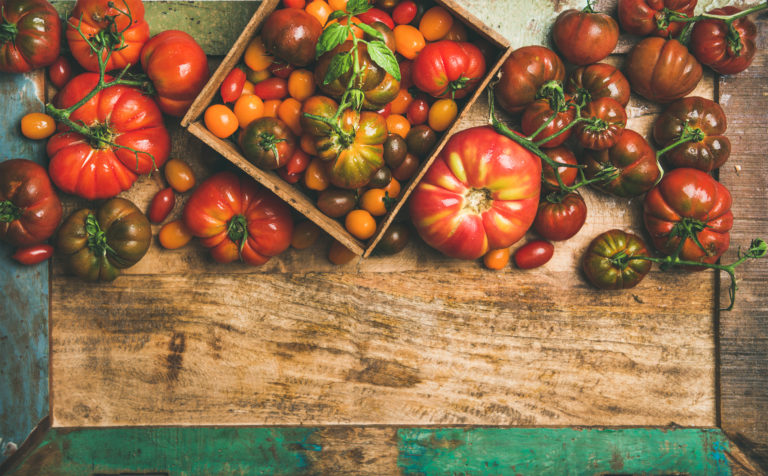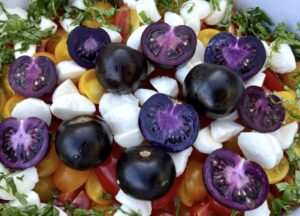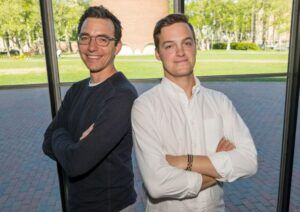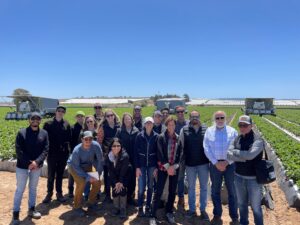The food system is a tale of two halves today. On one side, consumers want to go back in time to eat locally-sourced, clean, simple, organic produce, including a growing taste for vintage varieties of certain fruits and vegetables. Technically called landrace or heirloom varieties, the most familiar are tomatoes, but we’re also seeing a return to pre-genetically engineered varieties of commodity crops including popcorn.
On the flip side, technological advancements are making genetic engineering (GE) more commonplace as the discovery of new genetic tools, most famously CRISPR Cas-9 gene editing, has brought down the cost and accessibility of the technology.
GE, coupled with other developments of the Green Revolution such as the introduction of chemical fertilizers and mechanization, heralded in a new era of agricultural productivity. The “father of the Green Revolution” and Nobel Peace Prize laureate Norman Borlaug credited with saving a billion lives in developing countries with his new research into new crop varieties and farm management practices. Yet, recent headlines have been filled with potentially disastrous consequences of industrial agriculture: marine dead zones, greenhouse gases, soil and water contamination, decreasing numbers of family farms, and more.
As we move into future climate change, food security issues beg the question: is GE, and more broadly industrial agriculture–in our best interests? Or could small-scale agriculture, including a return to heirloom crop varieties, be relied upon to steer us into a sustainable future?
To dive into the technology and risk factors at play, and the potential solutions within our reach, we spoke with six different experts from across the supply chain:
- Matthew Dillon, senior director of Agriculture at Clif Bar & Company, founding executive director of Organic Seed Alliance, & former USDA National Genetic Resources Advisory Council member.
- Kristyn Leach, Farmer at Namu Farm, and a member of Organic Seed Alliance. Leach grows small-scale fresh market produce, commercial vegetable seeds, and field trials for Kitazawa Seed Company.
- Dr. Ryan Dierking, research scientist at AgriThority. Dr. Dierking specializes in plant responses under field conditions.
- Raquel Defacio, PhD, serves as both director of the Germplasm Bank at the Pergamino Experimental Station, run by Argentina’s National Institute of Agricultural Technology (INTA), and professor at the University of Northwestern Buenos Aires (UNNOBA).
- Marcelo Ferrer, MSc, previously a director of INTA’s Germplasm Bank, currently serves as a genetic resources and biosecurity consultant for both the Argentinean government and the Food and Agriculture Organization (FAO). Mr. Ferrer also holds numerous academic roles across several universities.
- Ignacio Colonna, MSc, research manager at AgriThority, is also an external consultant for numerous agtech research projects. Mr. Colonna previously worked for 10 years in Pioneer Hi-Bred’s breeding group in Argentina.
Below are these industry experts’ thoughts on a sustainable food system in a future of climate change. While their expert opinions don’t always align, the following article explores where we are today, the pros and cons of both genetic engineering and heirloom varieties, and how to balance industrial and small-scale agriculture in a future of uncertain climate change.
Are there limitations to GE?
Colonna: Relying on a narrow genetic basis to cope with biotic and abiotic stresses, either from transgenic sources or artificial selection, will very likely imply a higher variability in crop production, regardless of whether this is or isn’t associated with a long term trend in environmental conditions.
Defacio and Ferrer: Exactly. When sowing large areas with species with a very narrow genetic base, the system is exposed to a great vulnerability that, in the event of any biotic or abiotic change, can produce large losses of germplasm and, consequently, food.
Dillon: Breeding for uniformity and industrial scale is much more than tailoring crops to chemical treatments. It’s also about uniformity for mechanization and efficiencies, as well as disease resistance.
One of the key limits in GE is that it primarily works on traits that are a single gene, versus polygenic traits. Many of the most important traits (nutrition, flavor, and even durable disease resistance) are polygenic. One challenge with single gene traits is that pests can evolve beyond the resistant trait relatively quickly.
Leach: Modern GE techniques can expedite certain outcomes. However, those breeding practices usually rely on single or dual-trait breeding. They don’t take into account the ways that plants evolve and build resilience in complex ways, and in relationship to agronomic practices.
Defacio and Ferrer: With decreasing genetic variability, it is likely that a production ceiling will be reached, and the vulnerability of the species will intensify. For this reason, it will be essential to incorporate new germplasm which extends the genetic variability of the species, and consequently the possibility of obtaining new favorable gene combinations.
Dierking: While it is true that everything has limits, we have not yet seen yields plateau. If you take the yield contest winners in corn and soybean, it is clear that some of our major row crops have the capacity to yield 2 to 3x what they regularly produce on average today.
Are we relying too much on GE?
Dierking: Through current, desired crop selection, we have placed hard selection pressure on certain traits, which may result in the loss of others. [learn about linkage drag here.]
We are selecting plants that have been engineered to thrive in production settings where the plants do not have to regularly face competition from weeds, nutrient shortages, drought, and insects due to precise herbicide, fertilizer, irrigation, and insecticide application methods.
Essentially, we are selecting plants that thrive under specific agricultural practices/management.
Defacio and Ferrer: From the genetic point of view, monocrops are very exposed to any climate change or the presence of new pests and diseases. Four great examples:
- Irish Potato Famine of the 1840s: an attack of blight (Phytophtora infestans) caused total loss of the potato crop (Solanum tuberosum). The resulting famine caused the death of two million people, and massive emigration. The problem was solved only when resistance genes were found in primitive potato cultivars and related wild species in the centers of origin.
- 1940 Leaf Blight: Victoria blight (cochliobolus victoriae) attacked oats (avena sativa L.), affecting 97% of the area planted in Iowa, as well as a large percentage in other US states. Affected plants carried a pleiotropic gene introduced through genetic improvement to confer resistance to crown rust (puccinia coronata avenae).
- 1970 Corn Crisis: Production in Iowa decreased by 50%, thanks to an epiphyte granted the opportunity to thrive by Southern Leaf Blight (cochliobolus heterostrophus). The sterile Cytoplasm T (Texas), present in 75-90% of the cultivated hybrids, was very susceptible to blight. The problem was solved through plant breeding, using genetic resources obtained from other parts of the world.
- Soviet Wheat Loss in the 1970s: 15 million hectares of “Bezostaja” wheat (Triticum aestivum L.) were lost during a severe winter. The culprit? The massively commercialized germplasm was not adapted to such temperatures.
Leach: Mono-cropping and many industrial farming methods create more uniformity that can yield within an anticipated range. The risks are more in the long term.
This short term productivity is inextricable from the chemical regiments required to see desired results. It’s also financially taxing on farmers who need to purchase fertilizer and pesticide and herbicide from year to year.
It divorces sound farming practices from plant genetics. Traits like drought resistance are not just a matter of a particular part of the genome that regulates RNA. Rather, drought resistance/resilience can be developed over time by good farming practices and having a diversified system that can weather unpredictable stimuli.
Our lack of ability to see the ways things operate in systems leads to strategies which target particular members (spraying for certain pests or weeds). This only encourages those members to evolve. By narrowing the expression of any given plant’s genetics to address a few anticipated stressors, and limiting variability, those plants are susceptible and vulnerable when those stressors become more unpredictable.
What are the benefits of landrace (heirloom) varieties and operations?
Leach: Traditional seed saving and improvement allows the seed to attune to various environments and farming systems, and is equipped with a range of genetic traits to thrive in various situations. Farmer-led selection supports many other positive outcomes in boosting a robust food system:
- Deepens a farmer’s relationship with their crops and land.
- Creates a seed bank which can be more regionally adapted to share with other local growers.
- Often, it is shaped by the culinary preferences within that region.
Seed diversity and regionally adapted seeds give us a more diverse set of tools and strategies to ensure food production. There is still a need to address the broader systemic problems that contribute to food insecurity, but we can already see examples of agroecological approaches helping to maintain and rebuild food systems in places severely impacted by climate change in Puerto Rico and India.
Sometimes, I think my farm is too biological! My farm provides food and habitat for birds, small mammals, and various other lifeforms. At times, it creates challenges for one crop or another. The saving grace is that I grow enough variety that, even if I lose one or two crops each season, I have more than enough to meet the needs of my market.
Each season, my farm becomes more and more calibrated as a system unto itself. My crops develop intelligence which allows them to adapt and thrive. I have been able to use less water because of soil building practices that are tied to crop rotation, and I don’t purchase any fertilizer.
Dillon: While agroecological systems do not currently yield as high as the tech-chem treadmill approach, much of that is due to lack of investment. Organic research in the US receives under 1% of all public funding. In the private sector, it’s even less.
There are some indicators that we are seeing an increase in small scale production in the US. However, this is far outweighed by the trend of global consolidation and scaling up in the size of farms, and concentration in ownership and control of seed.
In general, the trend is to continue to narrow germplasm within crops, and to continue to narrow the crops we rely on. The latter is just as big of an issue–if not more–as diverse rotations offer so many ecological benefits, so long as farmers have markets to sell them into.
What are the downsides to landrace (heirloom) varieties and operations?
Dillon: Lack of uniformity. Lack of modern disease resistance. Don’t ship as well. And consumers not understanding the true cost of food production when done sustainably, and instead of wanting “cheap food” is also at play.
A greater variety of species may mitigate risk, but it also requires more management, often different equipment, and a need for a wider skill set.
Defacio and Ferrer: In general, they have poor agro-morphological characteristics. For example: in maize, they have lower yields, and more stalk and root lodging. These varieties were informally selected by farmers under conditions which are not those required by the current large-scale production system and market.
Colonna: Growing a large variety of species creates a commercial risk due to the logistic challenges of managing and marketing a large number of different crops. Selling multiple species requires a much more commercially skilled farmer, and time spent in the marketing process.
Dierking: They don’t fit into production agriculture: they are either too big or small, don’t harvest well with machines, have poor seedling vigor, take too long to bring into production, fruit doesn’t ship well, have short shelf life, produce smaller yields, are productive only in specific regions, possess uneven fruit ripening, are labor intensive, etc.
Growers in commercial operations need the equipment and knowledge for every crop they grow. Additionally, there needs to be a market for the products/commodities.
Currently, there is only a small or limited market for most heirlooms or specialty crops. Therefore, it would not be profitable for most growers to work with multiple species, crops, or heirlooms varieties due to the specific knowledge, equipment, and lack of broad demand.
What role do seed banks play in the future of food security?
Dillon: Breeders often go back to older germplasm to find new forms of resistance to pests and abiotic stress, as well as other characteristics that consumers want, and farmers need. It’s incalculable value, but we as taxpayers spend less than twenty-cents a year on it. We need to up our investment.
KL: Ex situ conservation of genetics can only protect us to a certain extent. Protecting the in situ diversity by caring about small farm livelihoods globally is equally important.
Dierking: They are immensely important! Scientists fully understand why collecting and preserving germplasm is necessary to keep a record of the diversity of crop variants.
In the US, we have many centers which store “ecotypes” that have been collected around the world that are available for scientists to study and evaluate.
Defacio and Ferrer: Use of the variability conserved in germplasm banks is becoming increasingly important worldwide. Author note: remember those 4 “disaster” scenarios, and their solutions above?
Conserved variability can provide genes/alleles to correct problems.” In Argentina, INTA’s network of germplasm banks makes up 93% of conserved plant genetics, with the remainder held in universities and other public institutions. “Local populations, farmers’ varieties and obsolete varieties” possess characteristics which “are fundamental in the face of climate change conditions.”
How should we invest in the future of agriculture?
Leach: Small scale and peasant farmers around the world do the best work of preserving diversity. There is a whole world of farmer taxonomy that creates nuanced iterations of different crops. At times, this is not acknowledged for the work that it is.
Dierking: I think there will always be a place for heirlooms, but I do not foresee them being a prominent component to the food security solution. The trend is to become more mechanized, not less, and with the heirloom not being adapted in that way, it will make producing these varieties on a large scale difficult and expensive.
Dillon: Too many people think, “GMO = bad. Heirlooms = good.” We don’t have to settle for heirloom, and we don’t have to reduce ourselves to high input ag-chem approaches to breeding.
With climate change, we need greater diversity:
- in the number of crops we grow;
- in the diversity within those crops (heterozygosity vs. an obsession with uniformity);
- and, in the scales of farming (larger scale drives greater homogeneity).
The solution isn’t all small and local, or all super-efficient megafarms, but rather a diverse spectrum of farming operations. We’re losing that, and the seeds which support that diversity of farming operations.
What do you think? Let us know! Email [email protected]

















Guest article: Why is routine antibiotic dosing still used when we have better livestock and aquaculture health solutions?